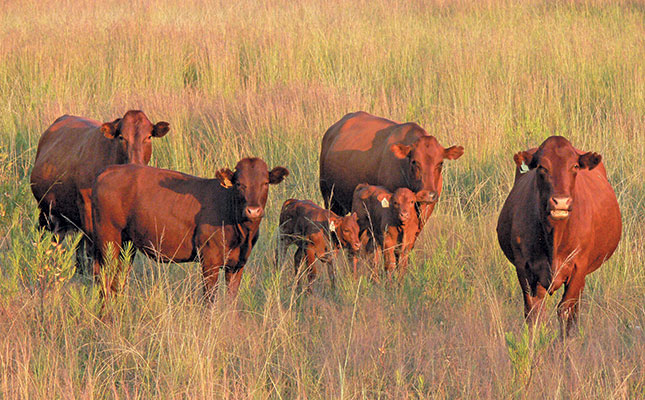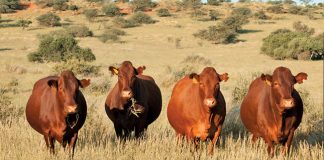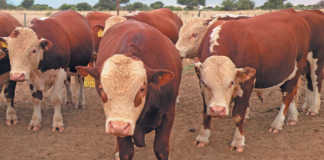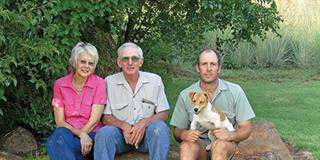
Very occasionally, one finds a cow that drops twins as if this is the most normal thing in the world and has little trouble weaning them at respectable weights – provided she is well fed. An outstanding example was the Simmentaler cow BM 90 4 Mont-Beau Janet, bred and owned by Ken and Tessa Baxter of the Mont-Beau Simmentaler Stud, Piet Retief.
As reported in Farmer’s Weekly (13 November 1998), this cow, twice the winner of the Super Cow Award at the Rand Show, had had 12 calves by the time she was seven years and eight months old – with the first five calvings all being twins, and without any artificial stimulation.
Remarkably, her intercalving period (ICP) was lower during the years in which she had twins than during the subsequent years when she had singletons.
Another exceptional cow – PHR D 136 – was bred by the Van Rooyen brothers of the Umpukane Bonsmara Stud near Clocolan in the Free State a number of years ago. In fact, in a sales catalogue, she was featured with her dam PHR X 20 as “22 years and 22 calves”.
Her dam was an F1 cow that had had 10 calves, all singletons, in 12 years. PHR D 136 had had 12 calves – including three sets of twins – by the time she was 10 years old and had weaned them all.
Dr Stanley Janyk, senior researcher in reproduction physiology at the Agricultural Research Council (ARC) Animal Improvement Institute, Irene, ascribed such remarkable reproductive efficiency to a number of factors – genetic composition, constitution, good nutrition and maintenance, and proper management. In beef breeds, he stressed, twins were acceptable because beef-type animals could handle twin pregnancies without negative effects on their reproduction and general health.
Even different- sex twins could be economically utilised, as the freemartin calf was a valuable slaughter animal, or, as Arthur de Villiers of the Arcadia Bonsmara Stud in Vrede had experienced, ‘the ultimate teaser bull’.
Janyk pointed out, however, that the body conformation of cows in dairy-type cattle differed significantly from that of beef-type cows. Every gestation resulting in twins has a negative effect on the following conception and lactation, in addition to the physical condition of a high-lactating cow.
Breeders of dairy cows, perhaps even more so than breeders of beef cattle, select for ease of calving, high milk production, a short ICP, regular calving and good general health. A high frequency of twins can therefore be of considerable economic benefit in an intensively- produced beef operation. On the other hand, it is less desirable in dairy breeds, where it creates problems with the productivity and longevity of the cow.
Frame size apparently plays an important role in twinning in cattle. Worldwide, twins do not occur at a higher than average frequency in small cattle breeds. Higher twinning frequency is more predominant in the larger breeds with cow weights ranging from 665kg to 800kg; therefore there seems to be some genetic correlation between twinning and a larger mature size.
A larger body seems to be better capable of handling the additional stress of carrying twins.
So, it is all a question of balance and compromise. While a 960kg cow and the resulting late-to-mature carcass is of limited use to the beef industry, small cows of much less than 640kg may not be of much use to practical twinning technology.
Dr Fanie van Rensburg, Brahman breeder, cattleman, and chairperson of the former Meat Board, saw room for a well-planned and managed twinning programme under intensive conditions. But he added a cautionary note.
“Only large-frame cows really have the ability to bear and successfully care for twins. Large frame cows have higher feed requirements and tend to be less fertile. Under extensive conditions, it becomes uneconomical to produce beyond the capacity of the veld. In the final analysis, the only way for most South African beef producers to survive economically is to produce off the veld – and keep debt as low as possible,” he said.
Final word
The last word should go to the late Prof Johan Grosskopf, Bonsmara breeder, former president of SA Stud Book and the Bonsmara Cattle Breeders’ Society of SA, as well as the honorary president of the SA Society of Animal Science.
“The commercial cattleman cannot afford to give his breeding cows better nutrition than natural veld,” he said. “It has been shown, time and time again, that it is uneconomical to produce beef on pasture, even with a 100% calving rate. That same pasture is, however, an economical proposition for young growing cattle. On the other hand, two young growing animals from one cow will be better than one.”













